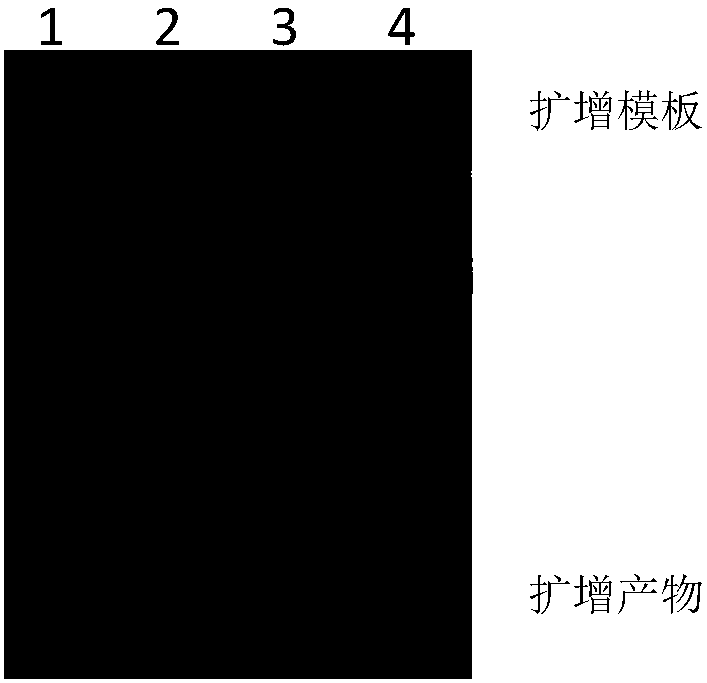Colorimetric sensor for cadmium-based functional nucleic acid and application of colorimetric sensor
A technology of functional nucleic acid and cadmium ions, which is applied in the field of colorimetric sensors for functional nucleic acids, can solve the problems of low sensitivity, poor repeatability, and limitations, and achieve high specificity and sensitivity, resistance to high salt cost, and high specificity
- Summary
- Abstract
- Description
- Claims
- Application Information
AI Technical Summary
Problems solved by technology
Method used
Image
Examples
Embodiment 1
[0054] Example 1: Construction method of colorimetric sensor based on functional nucleic acid
[0055] 1. Experimental materials
[0056] Potassium Chloride, Sodium Chloride, Magnesium Chloride, Potassium Hydrogen Phosphate, Disodium EDTA, Thio Yellow, Tris, Cadmium Chloride, Urea, Nt.BstNBI Cut Endonuclease, Bst DNA polymerase, 4-hydroxyethylpiperazineethanesulfonic acid (HEPES), sodium hydroxide, disodium hydrogen phosphate.
[0057] 2. Sequence design
[0058] Design and synthesis of DNAzyme substrate chains, DNAzyme chains and amplification templates. GACTC in the amplification template is the Nt.BstNBI nicking endonuclease recognition sequence, and the first four base pairs of the sequence (between C and A) are the synthetic strand cleavage sites; the CGGCCGGG sequence at the end of the deoxyribozyme substrate chain is In order to increase the binding Tm value to the amplified template; the cadmium ion cleavage site is after the rA of the DNAzyme substrate chain.
[0...
Embodiment 2
[0081] Example 2: Detection of Cadmium Ions
[0082] The specific steps for the detection of cadmium ion concentration are as follows:
[0083] (1) Prepare a standard curve of fluorescence intensity as a function of cadmium ion concentration
[0084] Adopt the construction method of 3 in Example 1, the cadmium ion solution to be tested is a cadmium chloride standard solution (1M NaCl is a dissolution environment), the cadmium chloride concentration is 30pM, 4560pM, 75pM, 90pM and 115pM, and the excitation wavelength is set to 425nm, A standard curve of the fluorescence intensity (FL) at 485 nm with the concentration of cadmium ions was prepared ( image 3 ), the standard curve is y=108.10-773.10, R 2 =0.9998.
[0085] (2) In the present embodiment, the cadmium ion solution to be tested is a cadmium chloride solution of different concentrations (NaCl is a dissolution environment)
[0086] Using the construction method of 3 in Example 1, measure the fluorescence intensity of...
Embodiment 3
[0089] Example 3: A kit for detecting cadmium ions
[0090] A kit for detecting cadmium ions, comprising a cadmium ion deoxyribozyme system, an isothermal amplification system and a color developing system;
[0091] The cadmium ion deoxyribozyme system includes substrate chain, enzyme chain, buffer solution, cadmium ion standard solution and stop solution;
[0092] The isothermal amplification system includes amplification template, dNTPs, ultrapure water, Bst DNA polymerase, polymerase reaction buffer solution, Nt.BstNBI nickase and Nt.BstNBI nickase reaction buffer solution;
[0093] The color developing system includes: thioxanthine stock solution and color developing buffer.
[0094] The sequence (5'-3') of the DNAzyme substrate chain is: CTCACTATArAGGAAGAGATGCGGCCCGGG;
[0095] The sequence (5'-3') of the DNAzyme chain is: CATCTCATCTAACAGCGTTCCGAAATAGC;
[0096] The sequence (5'-3') of the amplification template is: CCCAACCCGCCCTACCCCCCAACCCGCCCTACCCAACTGACTCCCCGGCCGCA...
PUM
 Login to View More
Login to View More Abstract
Description
Claims
Application Information
 Login to View More
Login to View More - R&D
- Intellectual Property
- Life Sciences
- Materials
- Tech Scout
- Unparalleled Data Quality
- Higher Quality Content
- 60% Fewer Hallucinations
Browse by: Latest US Patents, China's latest patents, Technical Efficacy Thesaurus, Application Domain, Technology Topic, Popular Technical Reports.
© 2025 PatSnap. All rights reserved.Legal|Privacy policy|Modern Slavery Act Transparency Statement|Sitemap|About US| Contact US: help@patsnap.com



